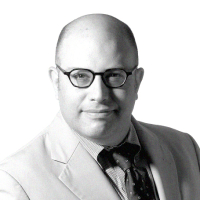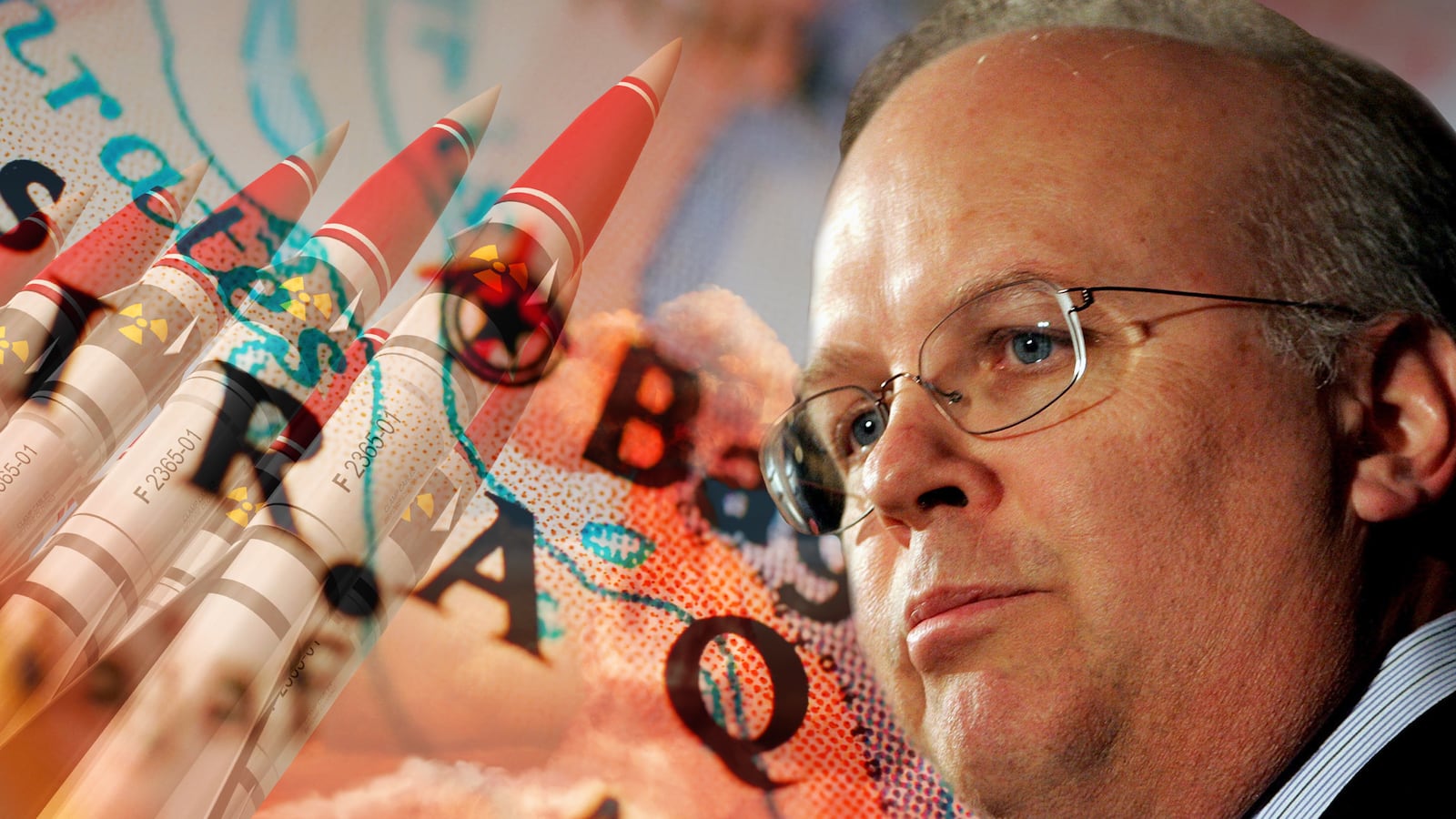Starting in 2004, some members of the George W. Bush administration and Republican lawmakers began to find evidence of discarded chemical weapons in Iraq. But when the information was brought up with the White House, senior adviser Karl Rove told them to “let these sleeping dogs lie.”
The issue of Iraq’s WMD remnants was suddenly thrust back into the fore this week, with a blockbuster New York Times report accusing the Bush administration of covering up American troops’ chemically induced wounds.
To people familiar with the issue, both inside that administration and outside, the blame for the coverup falls on one particular set of shoulders: Rove’s.
From the perspective of Rick Santorum, a Republican senator from Pennsylvania who lost his seat in 2006, some of the weapons of mass destruction President Bush promised would be in Iraq before the 2003 invasion of the country began turning up as early as 2004.
In an interview with The Daily Beast, Santorum said he and his staff began receiving photographs of discarded sarin and mustard-gas shells from U.S. soldiers in 2004. Two years later, when he was up for re-election, Santorum even went public with some of this information in a press conference disclosing a Pentagon report that found 500 chemical-weapons shells had been found in Iraq.
One might think a politically vulnerable Bush White House would’ve seized on Santorum’s discovery. After all, Bush and his subordinates famously accused Iraq of having active weapons of mass destruction programs.
But at least in 2005 and 2006, the Bush White House wasn’t interested. “We don’t want to look back,” Santorum recalled Rove as saying (though Santorum stressed he was not quoting verbatim conversations he had more than eight years ago). “I will say that the gist of the comments from the president’s senior people was ‘We don’t want to look back, we want to look forward.’”
Dave Wurmser—who served at the time as a senior adviser to Vice President Dick Cheney on national-security issues—remembers receiving a similar message from Rove.
According to Wurmser, “in 2005-6, Karl Rove and his team blocked public disclosure of these (findings) and said ‘Let these sleeping dogs lie; we have lost that fight so better not to remind anyone of it.’”
Rove declined to comment for this story.
At least part of the Bush administration’s case against Saddam Hussein was based on the fact that he never properly accounted for the chemical-weapons stockpile he had built up in the 1980s. As Santorum himself said during his 2006 press conference, the Pentagon’s report at the time “proves that weapons of mass destruction are, in fact, in Iraq.”
Santorum on Thursday stood by that claim. “There was no active chemical-weapons operation in Iraq—that doesn’t mean there were no chemical weapons,” he said. “That was the point we were making. It’s clear from The New York Times’ article that the military as well as the administration didn’t want to have that conversation because they missed it.”
Santorum said that in 2005 he began raising the issue with the White House himself. “I had discussions over a period of a year or two. Why aren’t we mentioning this? Why aren’t we doing anything on this?” he recalled. But Santorum later became so frustrated that by 2006, his message to the White House was: “I am going to do this [go public] whether you do it or not.”
One former senior White House official who requested anonymity confirmed that the White House had no interest in 2006 in re-engaging the public debate over weapons of mass destruction in Iraq. He said that other lawmakers had recommended Bush give a press conference with some of the discarded weapons wearing a protective suit.
“We killed that idea at the time,” the former official said. “It’s not a good idea to have the president near this stuff, it’s very dangerous.” This former official said that there were attempts from the White House in 2004 to get some in the media to write about the issue, but the narrative about Iraq and the weapons of mass destruction was already fixed in the mind of the public and the press. “There was not much we could do on this,” this official said.
Nonetheless, Santorum and others continued to press the White House. In the House, Pete Hoekstra, who was then the Republican chairman of the House Permanent Select Committee on Intelligence, conducted his own investigation into the older chemical weapons that were showing up in Iraq.
In an interview Thursday, Hoekstra declined to name Bush administration officials with whom he spoke. But he said he felt stonewalled during his own investigation in 2005 and 2006 into the issue. “This was an active investigation by the intelligence committee and they chose not to answer our questions truthfully and fully,” Hoekstra said.
Indeed, when Hoekstra teamed up with Santorum in 2006 to present the Pentagon finding about 500 chemical-weapons warheads, he said the Pentagon was much more critical of the information than the media or the Democrats.
“They came out and said these were not the weapons we were looking for,” Hoekstra said. “Somewhere along the line we were talking to people who were lying to us. This has to reach fairly far and fairly high. I am absolutely furious about it.” At the time, David Kay, the first head of the team of weapons inspectors in post-invasion Iraq, said the munitions publicized by Hoekstra and Santorum in 2006 were “less toxic than most things that Americans have under their kitchen sink at this point.”
One explanation for why the White House was not interested was so as not to tip off Sunni insurgents in Iraq. As The New York Times reported this week, some of the main areas in Iraq used to store chemical weapons are in areas now controlled by ISIS.
Wurmser said that in 2004 and 2005 “chemical-weapons shells began turning up in arms markets in Iraq in small numbers, but eventually in batches of 100 or so.” He said that when he asked the U.S. intelligence community to go public with the information, they “quite properly asked it be kept quiet until they track down the source of the weapons so that they can secure it and not tip off Sunni insurgents to go and retrieve them themselves.”
Eventually, Wurmser said, Sunni insurgent groups did gain access to the shells in 2005. “There were to my memory at least two attacks on our soldiers using chemical weapons-rigged shells as [improvised explosive devices]. Fortunately, they were ineffectively weaponized and soldiers were wounded but not killed.”
Wurmser, however, grew more frustrated over time. “After waiting a year—during which we asked that the source of the batches be traced and followed to the location where the shells were being retrieved—we continued to see the trickle, but then discovered nobody was making any effort to track the source to the location of retrieval,” he said. “Instead, we were continuing to try to buy up some of the stuff in the market.”
After the U.S. found thousands of the old chemical-weapons shells, Wurmser and others at one point argued that they had an obligation to declare the stocks of chemical weapons under the Chemical Weapons Convention and destroy them. The United States was, after all, the occupier of Iraq and had assumed the country’s sovereign responsibilities as a signatory to the convention.
“It was all for nothing; Rove wanted the issue buried,” Wurmser said.
At the end of the day, Santorum said he would not call the White House behavior at the time a coverup, as was implied in The New York Times story. “I don’t know if I would use the term coverup,” he said. “I would just say they simply didn’t want to discuss it.”






